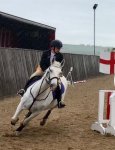Joyous70
Well-Known Member
Im looking for some advice, before you all say get a trainer, i am sorting to get someone out to help us, but would rather start helping myself in the mean time if i can.
My girl loves to jump, however, there is no adjustment in stride with her, once she sees a fence she is off, and woe betide you if you ask her to slow down, she will promptly stop at the next fence, it seems its her way or the highway, cue us flying around a 70cm course last weekend with me feeling rather like a passenger.
I think some of it is her balance, but im not sure how i can rectify this? if i put up raised poles at home she treats them like jumps and flies at them, i have tried halting after a fence, we usually manage to get back to trot before the end of the arena, she will throw her head and her body around to avoid being asked to stop, so far the only way to get her to stop is to ride her straight at something solid and preferably around 7 feet high. Does anyone have any useful ideas, tips or exercises we could try please. Picture of madam, motoring around the corner at the weekend, she may as well be at a gymkhana

My girl loves to jump, however, there is no adjustment in stride with her, once she sees a fence she is off, and woe betide you if you ask her to slow down, she will promptly stop at the next fence, it seems its her way or the highway, cue us flying around a 70cm course last weekend with me feeling rather like a passenger.
I think some of it is her balance, but im not sure how i can rectify this? if i put up raised poles at home she treats them like jumps and flies at them, i have tried halting after a fence, we usually manage to get back to trot before the end of the arena, she will throw her head and her body around to avoid being asked to stop, so far the only way to get her to stop is to ride her straight at something solid and preferably around 7 feet high. Does anyone have any useful ideas, tips or exercises we could try please. Picture of madam, motoring around the corner at the weekend, she may as well be at a gymkhana

Last edited:
